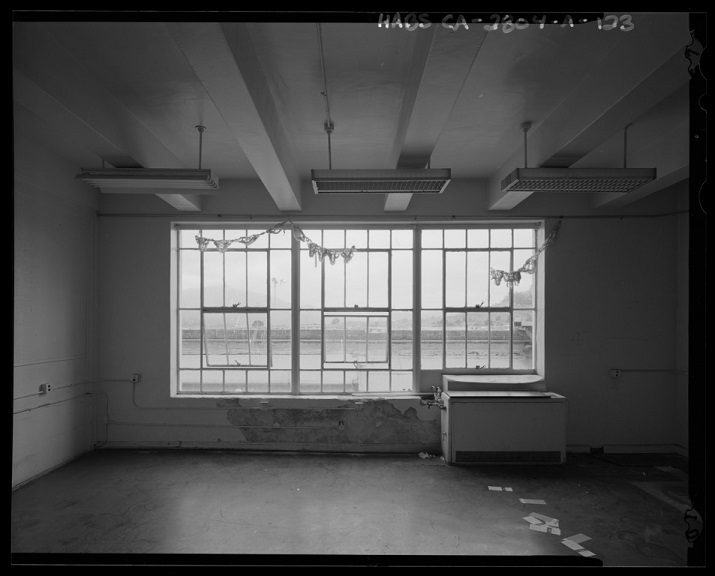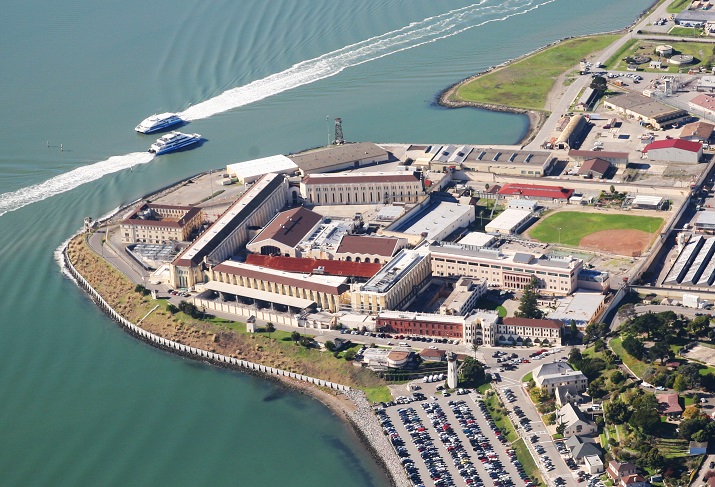
Interior details of room in Building C in San Quentin Robert a Hicks of the Historic American Building Survey [public domain] via Wikimedia Commons / Historic American Buildings Survey
Note: Jerry Elster, Healing Justice Program Coordinator in AFSC’s San Francisco office, presented at the recent Beyond Crime and Punishment: Fostering Crime and Punishment in Community conference, co-sponsored by AFSC at Pendle Hill. He told his story of transformation and peace-making at San Quentin on a panel on peacemaking in prison which included Jondhi Harrell. – Lucy
Entering prison, choosing change
My story starts with my entry into prison. My birthday is Oct. 30th. I committed my crime on Oct. 31st. I went to jail at twenty years old. When I went to prison, I was an angry young man. I hid my anger, but it manifested in my behavior. I was a bitter person. When I went to prison, I was gang member. I went to prison because I took the life of one of my gang rivals.
I spent the first 5 years of my incarceration in isolation, in solitary confinement. I had a spiritual awakening - this wasn’t who I was designed to be by the higher power. I wasn’t meant to be an angry individual. I realized that my anger was focused on the system, a system that discounted me and so many people a long time ago. My behavior was appropriate to a justice system that declared war against me a long time ago. I didn’t see I had an obligation to this system, this system that destroyed countless of my loved ones. There wasn’t going to be a great white hope that was going to save me. It was going to happen with me.
![Image by Robert A. Hicks for the Historic Am. Building Survey [public domain] via Wikimedia Commons](/sites/default/files/u144/Interior_building_details_of_Building_D%2C_Room_D-M1_detail_multi_pane_industrial_sash_windows%3B_westerly_view_-_San_Quentin_State_Prison%2C_Building_22%2C_Point_San_Quentin%2C_San_Quentin%2C_HABS_CA_0.jpg)
The life I was living was not the life I intended to live. I wasn’t living an authentic life, and I made a promise to the higher power: if the higher power would support me, I would do everything I could do to change my life. This helped me on the road to restorative justice. I was searching for meaning and purpose in my life, not just for myself but for my people. I tried to stay true to my purpose. I had a 7th grade education. I had gotten real enthralled and I was in a leadership level in the gang. We had one-hundred and some thousand prisoners. Prison had no problem with us being destructive to each other.
There were 3 cliques. I was at the top levels. When I saw that my education level was below a 7th grade reading level, I focused on it, and I improved myself. I still felt a void. I did all this self-improvement, but it was all head work, none of it from my heart. I had a new prayer and meditation. Some of the situations that I was confronted with, I started to be able to walk away.
“No More Tears”
Doors and opportunities started to open up. I created a program called, “No More Tears. “ At the time Oakland had 125 murders per year. We used that as a focal point to address the violence. We invited other people into the group from street organizations. We worked on changing the mindset of young men.
At the time no lifer was to be released. One objective was to effect change by promoting positive thought. We targeted the young men who were at risk for recidivism. Young brothers coming in affected the community.
While doing this and patting ourselves on the back, we thought we were beyond political warfare. But then San Quentin had a race riot. It would have been so easy to just react, but this one prisoner who became a Buddhist, he and I had been teaching for 8 years a better response than reaction, but to respond and not just react makes a difference. I was upset, too.
![Exit door in San Quentin, photo by Robert A. Hicks for the Historic American Buildings Survey [public domain] via Wikimedia Commons](/sites/default/files/u144/Interior_building_details_of_Building_B%2C_Room_B-215-_six-light_wood_casement_windows_over_a_single-pane_wood_door_with_four_light_exits_to_fire_escape%3B_easterly_view_-_San_Quentin_HABS_CA-_0.jpg)
African Americans were attacked on an African American holiday by another group of individuals. My friend said, “We can’t stop now, this is what you say you’re about, let’s push it.” I used my street cred and relationships in that situation.
These were young men that fell through the system. By design they had bought into it and become part of the system. These were the men who helped me to form “No More Tears.” And this young Buddhist man who used to be a skinhead, when he spoke into my ear and said, “We can,” at that moment I felt this warm, peaceful shelter. I was in situations where I felt touched by God and doors opened for me. I knew I didn’t want to live like that again. In the midst of this race riot, I felt peace, and I wanted all the other guys to feel it for one day. I wanted to teach them peace.
Working for a day of peace
First, I spoke to the guys I grew up with, my colleagues. I used our terminology, helping them recall where we had come from. I said, “Violence will beget violence. We aren’t here to put on a show for these folks.” I had to talk to guys who other people looked at and trembled. To their face, I said, “Let’s have a moment of peace.” It was crazy. When I heard the word come out of my mouth, one of my mentors said, “Just go through it.”
It was shocking when I went to the Aryan brotherhood with this idea. He ate it up, but I was expecting conflict. He said, “If they talk to the other guys and they say it’s cool, we trust you, we’ll go with it. If you go tell them, they are going to listen.” I approached the other groups and got the same result.
I said, “I know the problem came from both sides, why don’t we agree to disagree and have a moment of solidarity and just call it even.” Each one of them agreed to it.
Now we decided someone needed to talk to the police, the prison guards. I said, “Okay, I’ll do it.” I didn’t lay out this plan. The Spirit had just put things in place. There was an ex-gang officer who chased me through LA. I said to him, “We will create “No More Tears” and have a peace celebration.” When I went to the administration they said, “Are you crazy?” They kept sending me up the chain of command. I ended up talking with the associate warden.

I told him what we wanted to do. He said, “I’ll stand behind you.” If someone else had asked, he said he would have thrown them out of the office. He said, “You’ll have it this week.” The men wanted a sense of security and safety. They don’t mean not getting their stuff stolen, but that when they turn their back, they aren’t going to get stabbed.
When I finally got the approval, I thought I would be jubilant. But I thought, “If anything goes wrong, that’s on me.”
Everyone wore white t-shirts to support the day of peace. We walked down this blind spot at the top of the stairs above the lower yard. I walked up the stairs and the warden was there looking down at the yard with me. She looked at me, and I looked at her. She said, “Now they wear white t-shirts so you all know one another aren’t threats.” I said, “The white t-shirts aren’t for us, they are for you, so you know we aren’t a threat.”
Though there had certainly been peaceful days at San Quentin before, this was the first celebration of a day of peace there, the first time in history. They commemorate that event every year now, there’s an annual day of peace.
Related Content
On mass incarceration, movement building, and racism: A conversation with Daniel Hunter
On building a nonviolent revolution against injustice: A converation with Michelle Alexander